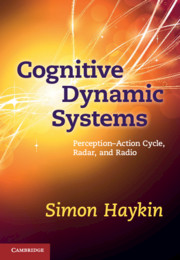Book contents
- Frontmatter
- Contents
- Preface
- Acknowledgments
- 1 Introduction
- 2 The perception–action cycle
- 3 Power-spectrum estimation for sensing the environment
- 4 Bayesian filtering for state estimation of the environment
- 5 Dynamic programming for action in the environment
- 6 Cognitive radar
- 7 Cognitive radio
- 8 Epilogue
- Glossary
- References
- Index
8 - Epilogue
Published online by Cambridge University Press: 05 June 2012
- Frontmatter
- Contents
- Preface
- Acknowledgments
- 1 Introduction
- 2 The perception–action cycle
- 3 Power-spectrum estimation for sensing the environment
- 4 Bayesian filtering for state estimation of the environment
- 5 Dynamic programming for action in the environment
- 6 Cognitive radar
- 7 Cognitive radio
- 8 Epilogue
- Glossary
- References
- Index
Summary
The perception–action cycle
We begin this final chapter of the book by reemphasizing the basic ideas that bind the study of cognitive dynamic systems to the human brain, where the networks dealing with perception are collocated with those dealing with action.
For a very succinct statement on the overall function of a cognitive dynamic system made up of actuator and perceptor, we simply say:
Perception for control via feedback information
Elaborating on perception performed in the perceptor and action performed in the actuator, we may go on to say:
(1) Cognitive perception addresses optimal estimation of the state in the perceptor by processing incoming stimuli under indirect control of the actuator.
(2) Cognitive control addresses optimal decision-making in the actuator under feedback guidance from the perceptor.
These two closely related functions reinforce each other continually from one cycle of directed information processing to the next. The net result is the perception–action cycle, discussed in detail in Chapter 2. This cyclic directed information flow is a cardinal characteristic of every cognitive dynamic system, be it of a neurobiological or artificial kind. Naturally, the exact details of the perception–action cycle will depend on the application of interest. In any event, a practical benefit of the perception–action cycle is information gain about how the state of the environment is inferred by the system, with the gain increasing from one cycle to the next.
- Type
- Chapter
- Information
- Cognitive Dynamic SystemsPerception-action Cycle, Radar and Radio, pp. 282 - 292Publisher: Cambridge University PressPrint publication year: 2012



